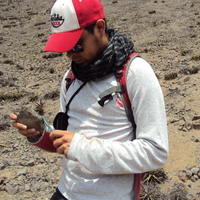Papers by Richard Bomphrey

Journal of fluid mechanics, 2015
Aerodynamic performance and agility during flapping flight are determined by the combination of w... more Aerodynamic performance and agility during flapping flight are determined by the combination of wing shape and kinematics. The degree of morphological and kinematic optimisation is unknown and depends upon a large parameter space. Aimed at providing an accurate and computationally inexpensive modelling tool for flapping-wing aerodynamics, we propose a novel CFD (computational fluid dynamics)-informed quasi-steady model (CIQSM), which assumes that the aerodynamic forces on a flapping wing can be decomposed into the quasi-steady forces and parameterised based on CFD results. Using least-squares fitting, we determine a set of proportional coefficients for the quasi-steady model relating wing kinematics to instantaneous aerodynamic force and torque; we calculate power with the product of quasi-steady torques and angular velocity. With the quasi-steady model fully and independently parameterised on the basis of high-fidelity CFD modelling, it is capable of predicting flapping-wing aerody...
Insekten vollbringen wahre fliegerische Meisterleistungen: Wenn Heuschrecken große Strecken überb... more Insekten vollbringen wahre fliegerische Meisterleistungen: Wenn Heuschrecken große Strecken überbrücken oder Motten über Blumen schweben, können Aerodynamiker nur staunen. Darum haben Forscher des Deutschen Zentrums für Luft- und Raumfahrt (DLR) zusammen mit der Universität Oxford und der Messtechnik-Firma LaVision den Flug von Heuschrecken und Motten in einem Windkanal in Göttingen untersucht. Modernste Messtechnik machte die Luftströmung hinter den Tieren in bislang unerreichter dreidimensionaler Auflösung sichtbar. Die Erkenntnisse bringen Ingenieure dem Bau von Mikro-Flugzeugen näher, die eines Tages ähnlich wie Insekten fliegen sollen.
Evolutionary Biology, 2012
Bioinspiration & Biomimetics, 2006
The study of insect flight has been advanced in recent years by the advent and application of new... more The study of insect flight has been advanced in recent years by the advent and application of new quantitative flow diagnostic techniques, not least digital particle image velocimetry. More classical qualitative methods such as smoke flow visualization have also been applied with new goals for the rigorous description of flows around insects. The combination of techniques has led to the development of ideas which may be of some consequence to the designers of micro-air vehicles wishing to follow a biomimetic principle. Specifically, kinematic parameters such as wingbeat frequency and amplitude are discussed, along with some discussion of the investigation of morphological parameters such as wing design.

Bioinspiration & Biomimetics, 2007
This paper introduces jumping robots as a means to traverse rough terrain; such terrain can pose ... more This paper introduces jumping robots as a means to traverse rough terrain; such terrain can pose problems for traditional wheeled, tracked and legged designs. The diversity of jumping mechanisms found in nature is explored to support the theory that jumping is a desirable ability for a robot locomotion system to incorporate, and then the size-related constraints are determined from first principles. A series of existing jumping robots are presented and their performance summarized. The authors present two new biologically inspired jumping robots, Jollbot and Glumper, both of which incorporate additional locomotion techniques of rolling and gliding respectively. Jollbot consists of metal hoop springs forming a 300 mm diameter sphere, and when jumping it raises its centre of gravity by 0.22 m and clears a height of 0.18 m. Glumper is of octahedral shape, with four 'legs' that each comprise two 500 mm lengths of CFRP tube articulating around torsion spring 'knees'. It is able to raise its centre of gravity by 1.60 m and clears a height of 1.17 m. The jumping performance of the jumping robot designs presented is discussed and compared against some specialized jumping animals. Specific power output is thought to be the performance-limiting factor for a jumping robot, which requires the maximization of the amount of energy that can be stored together with a minimization of mass. It is demonstrated that this can be achieved through optimization and careful materials selection. M This article features online multimedia enhancements
54th AIAA Aerospace Sciences Meeting, 2016
Philosophical Transactions of the Royal Society B: Biological Sciences, 2016

Plos One, 2014
Recent experiments on flapping flight in animals have shown that a variety of unrelated species s... more Recent experiments on flapping flight in animals have shown that a variety of unrelated species shed a wake behind left and right wings consisting of both tip and root vortices. Here we present an investigation using Particle Image Velocimetry (PIV) of the behaviour and interaction of trailing vortices shed by paired, fixed wings that simplify and mimic the wake of a flying animal with a non-lifting body. We measured flow velocities at five positions downstream of two adjacent NACA 0012 aerofoils and systematically varied aspect ratio, the gap between the wings (corresponding to the width of a non-lifting body), angle of attack, and the Reynolds number. The range of aspect ratios and Reynolds number where chosen to be relevant to natural fliers and swimmers, and insect flight in particular. We show that the wake behind the paired wings deformed as a consequence of the induced flow distribution such that the wingtip vortices convected downwards while the root vortices twist around each other. Vortex interaction and wake deformation became more pronounced further downstream of the wing, so the positioning of PIV measurement planes in experiments on flying animals has an important effect on subsequent force estimates due to rotating induced flow vectors. Wake deformation was most severe behind wings with lower aspect ratios and when the distance between the wings was small, suggesting that animals that match this description constitute high-risk groups in terms of measurement error. Our results, therefore, have significant implications for experimental design where wake measurements are used to estimate forces generated in animal flight. In particular, the downstream distance of the measurement plane should be minimised, notwithstanding the animal welfare constraints when measuring the wake behind flying animals.

Cell, 2016
How mechanical and biological processes are coordinated across cells, tissues, and organs to prod... more How mechanical and biological processes are coordinated across cells, tissues, and organs to produce complex traits is a key question in biology. Cardamine hirsuta, a relative of Arabidopsis thaliana, uses an explosive mechanism to disperse its seeds. We show that this trait evolved through morphomechanical innovations at different spatial scales. At the organ scale, tension within the fruit wall generates the elastic energy required for explosion. This tension is produced by differential contraction of fruit wall tissues through an active mechanism involving turgor pressure, cell geometry, and wall properties of the epidermis. Explosive release of this tension is controlled at the cellular scale by asymmetric lignin deposition within endocarp b cells-a striking pattern that is strictly associated with explosive pod shatter across the Brassicaceae plant family. By bridging these different scales, we present an integrated mechanism for explosive seed dispersal that links evolutionary...
Nature communications, 2016
Insect wing shapes are remarkably diverse and the combination of shape and kinematics determines ... more Insect wing shapes are remarkably diverse and the combination of shape and kinematics determines both aerial capabilities and power requirements. However, the contribution of any specific morphological feature to performance is not known. Using targeted RNA interference to modify wing shape far beyond the natural variation found within the population of a single species, we show a direct effect on flight performance that can be explained by physical modelling of the novel wing geometry. Our data show that altering the expression of a single gene can significantly enhance aerial agility and that the Drosophila wing shape is not, therefore, optimized for certain flight performance characteristics that are known to be important. Our technique points in a new direction for experiments on the evolution of performance specialities in animals.
54th AIAA Aerospace Sciences Meeting, 2016
Public reporting burden for this collection of information is estimated to average 1 hour per res... more Public reporting burden for this collection of information is estimated to average 1 hour per response, including the time for reviewing instructions, searching existing data sources, gathering and maintaining the data needed, and completing and reviewing the collection of information. Send comments regarding this burden estimate or any other aspect of this collection of information, including suggestions for reducing the burden, to Department of Defense, Washington Headquarters Services, Directorate for Information Operations and Reports (0704-0188), 1215 Jefferson Davis Highway, Suite 1204, Arlington, VA 22202-4302. Respondents should be aware that notwithstanding any other provision of law, no person shall be subject to any penalty for failing to comply with a collection of information if it does not display a currently valid OMB control number.

Bioinspiration & biomimetics, 2015
Insect wing shapes are diverse and a renowned source of inspiration for the new generation of aut... more Insect wing shapes are diverse and a renowned source of inspiration for the new generation of autonomous flapping vehicles, yet the aerodynamic consequences of varying geometry is not well understood. One of the most defining and aerodynamically significant measures of wing shape is the aspect ratio, defined as the ratio of wing length (R) to mean wing chord ([Formula: see text]). We investigated the impact of aspect ratio, AR, on the induced flow field around a flapping wing using a robotic device. Rigid rectangular wings ranging from AR = 1.5 to 7.5 were flapped with insect-like kinematics in air with a constant Reynolds number (Re) of 1400, and a dimensionless stroke amplitude of [Formula: see text] (number of chords traversed by the wingtip). Pseudo-volumetric, ensemble-averaged, flow fields around the wings were captured using particle image velocimetry at 11 instances throughout simulated downstrokes. Results confirmed the presence of a high-lift, separated flow field with a l...

Previously, stacking of planar 2D 3C PIV measurements have been used to create a pseudo 3D image ... more Previously, stacking of planar 2D 3C PIV measurements have been used to create a pseudo 3D image of insect and bird wakes. Assuming an ideal homogeneous transport of the flow features with the free stream velocity, vorticity vectors and flight efficiency had been estimated from the pseudo 3D vector fields, replacing spatial derivatives by time derivatives and accepting some level of uncertainty due to the violation of this assumption in real flow conditions. In this study tomographic PIV measurements allow the direct calculation of spatial derivatives leading to a more accurate evaluation of vortex structures. Tethered locusts appear to fly in a passive or active flight mode, where only the active flight mode resembles natural free flight conditions. Features extracted from velocity data allow an a posteriori classification of the flight mode. Limited laser power led to a relatively poor signal to noise ratio, requiring post processing to show the vortex structures more clearly. Pro...

Journal of The Royal Society Interface, 2015
Particle image velocimetry has been the preferred experimental technique with which to study the ... more Particle image velocimetry has been the preferred experimental technique with which to study the aerodynamics of animal flight for over a decade. In that time, hardware has become more accessible and the software has progressed from the acquisition of planes through the flow field to the reconstruction of small volumetric measurements. Until now, it has not been possible to capture large volumes that incorporate the full wavelength of the aerodynamic track left behind during a complete wingbeat cycle. Here, we use a unique apparatus to acquire the first instantaneous wake volume of a flying animal's entire wingbeat. We confirm the presence of wake deformation behind desert locusts and quantify the effect of that deformation on estimates of aerodynamic force and the efficiency of lift generation. We present previously undescribed vortex wake phenomena, including entrainment around the wing-tip vortices of a set of secondary vortices borne of Kelvin-Helmholtz instability in the shear layer behind the flapping wings.

PloS one, 2014
Recent experiments on flapping flight in animals have shown that a variety of unrelated species s... more Recent experiments on flapping flight in animals have shown that a variety of unrelated species shed a wake behind left and right wings consisting of both tip and root vortices. Here we present an investigation using Particle Image Velocimetry (PIV) of the behaviour and interaction of trailing vortices shed by paired, fixed wings that simplify and mimic the wake of a flying animal with a non-lifting body. We measured flow velocities at five positions downstream of two adjacent NACA 0012 aerofoils and systematically varied aspect ratio, the gap between the wings (corresponding to the width of a non-lifting body), angle of attack, and the Reynolds number. The range of aspect ratios and Reynolds number where chosen to be relevant to natural fliers and swimmers, and insect flight in particular. We show that the wake behind the paired wings deformed as a consequence of the induced flow distribution such that the wingtip vortices convected downwards while the root vortices twist around ea...

Journal of The Royal Society Interface, 2014
In vitro mechanotransduction studies, uncovering the basic science of the response of cells to me... more In vitro mechanotransduction studies, uncovering the basic science of the response of cells to mechanical forces, are essential for progress in tissue engineering and its clinical application. Many varying investigations have described a multitude of cell responses; however, as the precise nature and magnitude of the stresses applied are infrequently reported and rarely validated, the experiments are often not comparable, limiting research progress. This paper provides physical and biological validation of a widely available fluid stimulation device, a see-saw rocker, as an in vitro model for cyclic fluid shear stress mechanotransduction. This allows linkage between precisely characterized stimuli and cell monolayer response in a convenient six-well plate format. Models of one well were discretized and analysed extensively using computational fluid dynamics to generate convergent, stable and consistent predictions of the cyclic fluid velocity vectors at a rocking frequency of 0.5 Hz, accounting for the free surface. Validation was provided by comparison with flow velocities measured experimentally using particle image velocimetry. Qualitative flow behaviour was matched and quantitative analysis showed agreement at representative locations and time points. Maximum shear stress of 0.22 Pa was estimated near the well edge, and time-average shear stress ranged between 0.029 and 0.068 Pa. Human tenocytes stimulated using the system showed significant increases in collagen and GAG secretion at 2 and 7 day time points. This in vitro model for mechanotransduction provides a versatile, flexible and inexpensive method for the fluid shear stress impact on biological cells to be studied.
44th AIAA Aerospace Sciences Meeting and Exhibit, 2006

Microscopy research and technique, 2014
Iodine imparts strong contrast to objects imaged with electrons and X-rays due to its high atomic... more Iodine imparts strong contrast to objects imaged with electrons and X-rays due to its high atomic number (53), and is widely used in liquid form as a microscopic stain and clinical contrast agent. We have developed a simple technique which exploits elemental iodine's sublimation-deposition state-change equilibrium to vapor stain specimens with iodine gas. Specimens are enclosed in a gas-tight container along with a small mass of solid I2 . The bottle is left at ambient laboratory conditions while staining proceeds until empirically determined completion (typically days to weeks). We demonstrate the utility of iodine vapor staining by applying it to resin-embedded tissue blocks and whole locusts and imaging them with backscattered electron scanning electron microscopy (BSE SEM) or X-ray microtomography (XMT). Contrast is comparable to that achieved with liquid staining but without the consequent tissue shrinkage, stain pooling, or uneven coverage artefacts associated with immersi...
Journal of Experimental Biology, 2004







Uploads
Papers by Richard Bomphrey